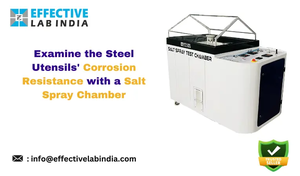More from Effective Lab India
More in Politics
Related Blogs
Les archives
Partage Social
Examine the Steel Utensils’ Corrosion Resistance with a Salt Spray Chamber
Corps
One important step in understanding how steel flatware will respond under simulated settings is corrosion testing. The testing procedure aids in guaranteeing the anticipated or approximate lifespan of the cutlery. Numerous production verticals use corrosion testing with a salt spray chamber for a range of purposes. These include taking proactive steps to gauge the quality of raw materials, understanding how a material reacts to environmental changes, and figuring out how much a material will cost and perform under real-world working conditions.
Testing the material’s capabilities and assisting producers in establishing a solid reputation in the market by offering clients high-quality products are two benefits of conducting a corrosion test on a sample. Determining the material’s appropriateness in various service settings requires careful consideration of modern, well-engineered testing instruments.
Results of Corrosion Test.
Materials, equipment, and other things can sustain damage due to corrosion. While these losses are costly to recover the financial problems, a failed product can also result in production delays, health problems, and safety hazards. Consequently, to ascertain the materials’ capacity to withstand corrosion, corrosion tests must be conducted on them.
Effective Lab’s Stantest provides a large range of salt spray chambers for testing the materials’ ability to withstand corrosion in various applications. The device provides incredibly accurate readings.
How a Salt Spray Chamber Operates
Steel specimens are subjected to a corrosive environment comprising saltwater mist in a controlled setting created by a salt spray chamber. This accelerated corrosion test replicates the impacts of prolonged exposure to severe environmental conditions.
Advantages of Testing in a Salt Spray Chamber
Testing in a salt spray test chamber has several benefits, such as speedy results, cost effectiveness, and reproducibility. In a short time, it enables producers to assess how well steel utensils function in harsh environments.
Performing the Examination
Considerable Parameters
To guarantee reliable findings, test conditions including temperature, humidity, and spray concentration must be properly regulated.
Length of the Examination
A salt spray test might take anywhere from a few hours to many weeks, depending on the utensil specifications and the desired level of corrosion resistance.
Interpreting Examination Findings
Following the test, the specimens are inspected for corrosion indicators, including as surface deterioration and rust development. The next step is employing standardised grading methods to assess the degree of corrosion.
Relationship with Actual Circumstances
While testing in a salt spray test machine offers insightful information about how resistant steel utensils are to corrosion, real-world usage conditions must be taken into account to guarantee product reliability.
Expanding the Resistance to Corrosion
Manufacturers can increase the corrosion resistance of their utensils by identifying areas for improvement and implementing design improvements or material upgrades based on test findings.
Conclusion
Salt spray chamber testing is a valuable tool for evaluating the corrosion resistance of steel utensils and ensuring product quality and durability. By conducting rigorous testing and implementing preventive measures, manufacturers can deliver safe and reliable utensils that meet the highest standards of performance and longevity.
FAQs
- How long does a salt spray test typically last?
- The duration of a salt spray test can vary depending on the specific requirements of the application, but it typically ranges from 24 to 96 hours.
- Are there any alternatives to salt spray chamber testing?
- Yes, there are alternative methods for assessing corrosion resistance, such as electrochemical testing and exposure to natural environments.
- Can stainless steel utensils corrode?
- While stainless steel is highly resistant to corrosion, it is not entirely immune. Factors such as exposure to harsh chemicals or extreme temperatures can still cause corrosion over time.
- Is corrosion a common problem in steel utensils?
- Corrosion can occur in steel utensils, especially if they are not properly maintained or exposed to corrosive environments.
- How can consumers identify corrosion-resistant steel utensils?
- Look for utensils made from high-quality stainless steel alloys and reputable brands known for their durability and corrosion resistance.














commentaires